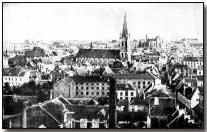Battles - The Destruction of Louvain, 1914

Between Liege and Brussels, the Belgian city of Louvain was the subject of mass destruction by the German army over a period of five days from 25 August 1914. The city itself fell to the German First Army on 19 August 1914 as part of the German strategy to overrun Belgium during the month of August 1914.
Occupied therefore by the Germans the city was relatively peaceful for six days until 25 August. On that date German units to the rear of the city were attacked by an initially successful Belgian force advancing from Antwerp.
Panicked, those German troops under fire withdrew to Louvain, which in itself caused confusion to German soldiers stationed in the city. Shots were heard amid fearful cries that the Allies were launching a major attack.
Once it became clear however that no such Allied attack was underway or even imminent, the city's German authorities determined to exact revenge upon Louvain's citizenry, whom they were convinced that contrived the confusion that day.
The German form of retaliation was savage. For five consecutive days the city was burnt and looted. Its library of ancient manuscripts was burnt and destroyed, as was Louvain's university (along with many other public buildings). The church of St. Pierre was similarly badly damaged by fire. Citizenry of Louvain were subject to mass shootings, regardless of age or gender.
As demonstrated earlier at other Belgian towns, including Dinant, the destruction of up to a fifth of Louvain's buildings merely comprised a standard German strategy of intimidating occupied Belgian territories as a means of securing maximum civilian co-operation.
Already widely regarded as an unacceptable strategy internationally, the treatment of Louvain provoked highly critical press headlines (which routinely referred to German barbarism and 'rivers of blood') and caused great concern in neutral capitals.
With the government in Berlin unrepentant, the German retaliation ceased on 30 August.
Click here to view footage of the sack of Louvain.
Click here to view of map charting the progress of the German invasion of Belgium in August 1914.
Photograph courtesy of Photos of the Great War website
Bulgaria mobilised a quarter of its male population during WW1, 650,000 troops in total.
- Did you know?
